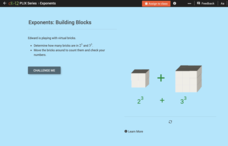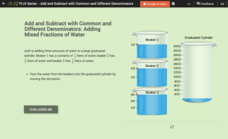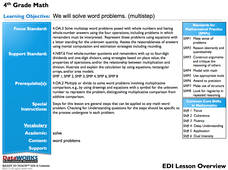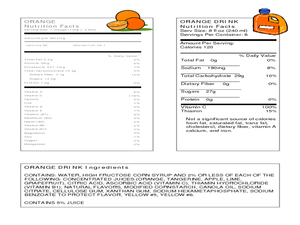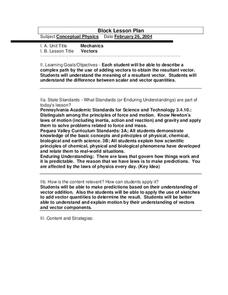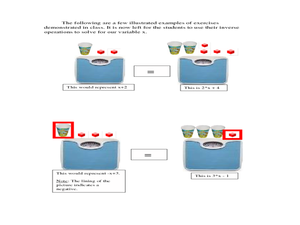CK-12 Foundation
Whole Number Exponents: Building Blocks
Five questions make up an interactive all about whole-number exponents. Movable building blocks create a visual tool to aide mathematicians in answering multiple-choice and true or false problems. The interactive ends with a discussion...
CK-12 Foundation
Expression Evaluation with Different Denominators: Adding Mixed Fractions of Water
An interactive challenges mathematicians to add mixed fractions with unlike denominators. Five questions—fill-in-the-blank and multiple-choice—build from one to the next leading the way to an open discussion about denominators and...
Curated OER
Matrix Analysis of Networks
Explore the connection between a finite graph, a directed graph, and a matrix. Graph lines and identify the relationship of matrices in real-world scenarios. Then use this information to work with a partner to plan and design a...
DataWorks
4th Grade Math: Multi-Step Word Problems
Solving word problems requires reading comprehension and math computation. Through an interactive slideshow presentation, fourth graders observe and follow each step toward solve multiplication and division word problems.
EngageNY
Read Expressions in Which Letters Stand for Numbers
Pencil in the resource on writing verbal phrases into your lesson plans. The 15th installment of a 36-part module has scholars write verbal phases for algebraic expressions. They complete a set of problems to solidify this skill.
Curated OER
Videobusters
A real-world scenario, Videobusters, a video rental store has just got to get organized. In small groups, the class works on organizing and analyzing data utilizing matrices. They need to use their skills in adding, subtracting and...
Curated OER
Handcarts - A Unique Form of Transportation
An interesting historical fact about how handcarts benefitted to the Mormon pioneers is the context behind this math lesson. Using given facts and figures regarding the handcart, pupil pairs create math word problems, share them with the...
Curated OER
Family at Home
Students fold paper to form a house, then use three numbers to make fact families for their houses. They write a family of multiplication and division facts on a piece of paper cut in the shape of a house.
National Security Agency
Introducing Integers and Their Operations
There's nothing negative about this mini-unit on integers! Engaging young mathematicians in a series of hands-on activities and collaborative learning opportunities, this resource offers an excellent way to introduce your class...
Curated OER
Begin with Buttons
Students utilize buttons to explore logical and numerical relationships. They focus on the two basic logical thinking skills, classification and seriation. Each student applies these developing skills to the operations of addition and...
Curated OER
Living on Your Own -- Let's Calculate the Cost!
Young scholars review basic math skills, such as addition, subtraction, multiplication, division, finding averages, and working with percentages. They see how these skills apply to real life situations.
Curated OER
Healthy Food is Good Food!
Learners examine the difference between whole foods and junk foods. In this food lesson, students learn the definitions of whole food and junk food. They find the difference in tastes and textures of different foods by performing taste...
Curated OER
Math
Students solve addition, subtraction, multiplication, and division problems that focus on serving size and counting 5 A Day.
Curated OER
Understanding Inequality Operation Rules
Young scholars solve problems within-inequalities. For this algebra lesson, students apply concepts of addition, subtraction, multiplication and division to solve inequalities.
Curated OER
Vectors
Students describe motion by the use of adding vectors to obtain the resultant vector. They comprehend the meaning of a resultant vector. Students identify the difference between the x and y components of vector quantities. Students...
Curated OER
Vectors
Students describe a complex path by the use of adding vectors. They comprehend the difference betwee scalar and vector quanitities. Students disucss the naviagation lab. They are explained the procedures for the lab. Students are...
Curated OER
Vectors
Young scholars are introduced to the bridge building challenge. They perform two labs and work in small groups to finish the vector worksheet. Students review vector additions. They then move onto the Forces on an Inclined Plane Lab. ...
Curated OER
Music Education, The Blues
This lesson plan examines both the content and form of lyrics in blues songs. In addition to highlighting the basic musical form of a blues song, it also addresses the use of floating verses in blues music, both within the context of the...
Curated OER
Weigh Out the Algebra
Learners solve linear equations. In this algebra lesson, students use manipulative's to see the steps taken when solving linear equations. They solve using addition, subtraction, multiplication and division.
Curated OER
Cartoon Fractions
Students explore mathematics by viewing cartoons. In this math functions lesson, students read several "Peanut" cartoons on their worksheets as they solve fraction problems and compare them to the comic strip. Students utilize addition,...
Curated OER
A Beginning Look at Basic Algebra-Lesson 1-12
In this Algebra I worksheet, 9th graders explore the basic of beginning algebra: the order of operations, integer operations, translating phrases and sentences, and solving basic one-step equations. The six page worksheet...
Curated OER
Math Facts Game
Students practice math skills while playing a flash cards game. When the teacher displays a flash card with a multiplication fact on it, students try to be the first to call out the correct answer.
Curated OER
Integer War
Sometimes all it takes for a good review is a game of cards. Review the processes needed to add, subtract, divide, and multiply integers. In groups, learners play the card game war with a twist. They can use the numbers as either...
Curated OER
"How Many Names for 100?"
Fifth graders work on the different possibilities of reaching the number 100. The class is divided into homogeneous groups for cooperative learning. The lesson uses discussion questions to help with problem solving.


